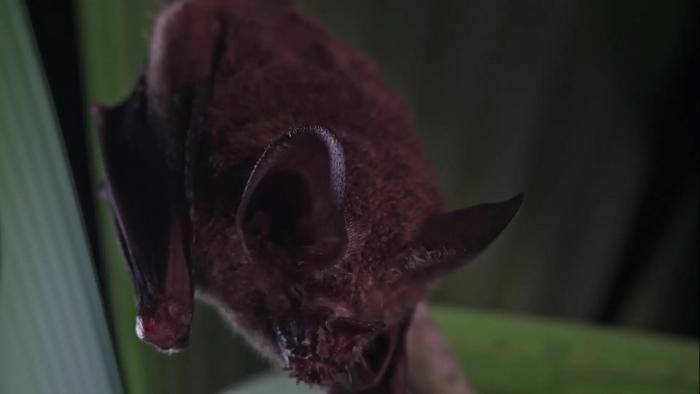
In the shadowed understories of Central and South American rainforests, a fascinating interplay unfolds between predators and prey—a complex acoustic battleground shaping survival and evolutionary success. Scientists at the Smithsonian Tropical Research Institute (STRI) have unveiled new insights into how fringe-lipped bats, one of the region’s most adept predators, learn to interpret the mating calls of frogs and toads to optimize their hunting strategies. Their study, recently published in the Proceedings of the Royal Society B, reveals that these bats refine their response to prey calls not innately, but through experiential learning across their development.
Fringe-lipped bats (Trachops cirrhosus) stand out in the annals of animal behavior for their skillful eavesdropping on the vocal signals of over a dozen sympatric frog and toad species. These calls, primarily evolved as sexual advertisements conveying location and fitness to potential mates, inadvertently serve as auditory beacons for bats seeking their next meal. Previous research established that adult fringe-lipped bats discern between palatable and toxic or otherwise unprofitable amphibians, but the ontogeny—the developmental trajectory—of this sophisticated auditory discrimination had remained elusive until now.
Researchers developed an experimental framework involving wild-caught juvenile and adult bats exposed to playback recordings of 15 local frog and toad species’ mating calls. The spectrum of these calls included signals from species that differ significantly in palatability—ranging from harmless and nutritious, to toxic, to those too large to handle. The controlled acoustic environment allowed the scientists to meticulously measure behavioral responses such as approach frequency and intensity, key indicators of predation motivation and decision-making processes.
The results underscore a striking developmental dissociation. Adult bats robustly differentiated calls of palatable prey from those signaling unpalatable or dangerous species, preferentially approaching the former. In contrast, juveniles lacked this nuanced discrimination, responding indiscriminately to both edible and toxic prey calls. Intriguingly, juvenile bats showed an early ability to assess prey size acoustically, avoiding calls from larger species beyond their handling capability, illustrating that body-size assessment develops prior to palatability recognition.
This developmental progression reveals the particular importance of experience in shaping foraging decisions. Juvenile bats likely encounter the costs of erroneous prey choice—such as ingesting toxins or injuries inflicted by oversized amphibians—during an extended trial-and-error learning phase. Over time, sensory association between particular acoustic signatures and adverse post-ingestive consequences refines their predatory acuity, effectively calibrating the bat’s auditory “caller ID” to the risks and rewards of the environment.
Beyond the fascinating behavioral dynamics lies a broader ecological and evolutionary context: the bats’ ability to eavesdrop on an unrelated species’ mating signals provides a compelling example of interspecific communication networks influencing natural selection. The acoustic signals produced by frogs, while primarily for intraspecific mating communication, inadvertently mediate predator-prey interactions. Such eavesdropping imposes selective pressures on signal design—a delicate balance between attracting mates and avoiding deadly predators.
Moreover, STRI’s findings emphasize the role of neural plasticity during critical developmental windows for sensory and cognitive functions in wild animals. Like human children who learn to differentiate social cues and dangers through experience, juvenile fringe-lipped bats must accumulate environmental data to fine-tune their responses to complex auditory stimuli. This highlights an adaptive strategy allowing flexibility in dynamic ecological landscapes where prey communities and predation risks can vary spatially and temporally.
Technically, the study utilized a battery of playback experiments wherein acoustic stimuli, standardized for intensity and fidelity, simulated natural call sequences from single males and large choruses of túngara frogs (Engystomops pustulosus). Behavioral metrics were quantified through video recordings and real-time observations, providing robust datasets to distinguish age-related differences in auditory-guided predation choices. The research also employed cross-validation with known palatability and toxicity profiles to cement links between behavioral responses and prey characteristics.
Additionally, the experiments shed light on the bats’ neural mechanisms for processing complex acoustic signals that feature dynamic spectral and temporal patterns. The intricate whine-plus-chuck call of the túngara frog, for instance, exemplifies a multimodal signal encoding species identity and mate quality. The ability of fringe-lipped bats to parse and react differentially to these calls indicates sophisticated auditory discrimination at neural circuitry levels, potentially involving both innate predispositions and learned associations.
Overall, this landmark research propels forward our understanding of predator-prey interactions mediated through sensory eavesdropping and learning. It invites further exploration of similar ontogenetic patterns in auditory discrimination across other taxa, highlighting the critical integration of experience, neuroethology, and ecological pressures. These insights not only enrich basic science but may also inform conservation efforts by elucidating the sensory ecology fundamental to species survival in increasingly disturbed tropical habitats.
In an era marked by rapid habitat transformation and biodiversity loss, recognizing the nuanced relationships between species and the emergent behavioral adaptations driven by sensory environments offers a pathway to more informed ecosystem management. The work of STRI researchers exemplifies the power of interdisciplinary field and laboratory research to decode the complex life histories unfolding in nature’s acoustic landscapes.
Subject of Research: Animals
Article Title: The Ontogeny of Decision-Making in an Eavesdropping Predator
News Publication Date: 29-Apr-2025
Web References: https://royalsocietypublishing.org/doi/10.1098/rspb.2025.0450
Image Credits: Credit: (c) Joseph See
Keywords: Animal research, Animal science, Behavioral ecology, Ethology, Ecology, Predation, Ecosystems, Neuroethology, Ecological dynamics
Tags: acoustic communication in rainforest ecosystemsanimal learning and developmentauditory discrimination in batsCentral American rainforest biodiversityeavesdropping batsexperiential learning in wildlifefringe-lipped bats hunting strategiesfrog and toad mating callslearning in animal behaviorpredator-prey interactionsSmithsonian Tropical Research Institute researchtoxic vs edible amphibians





